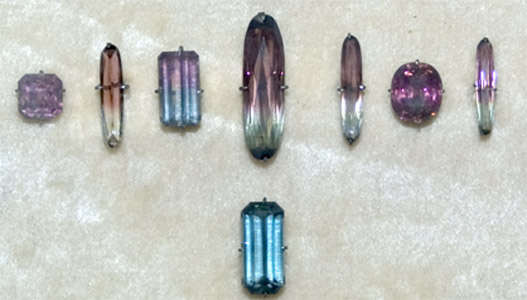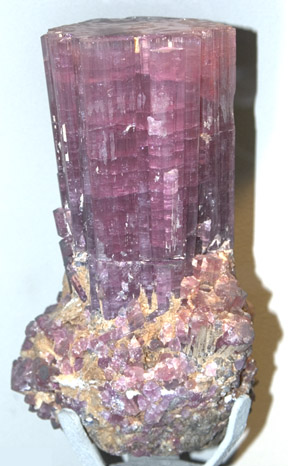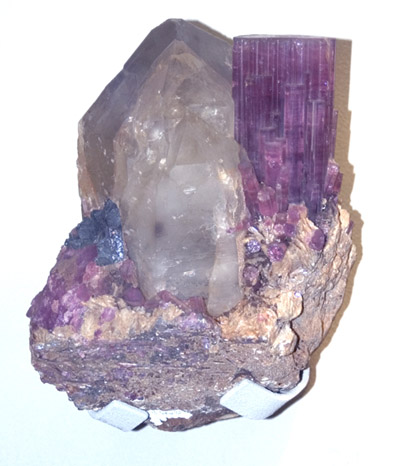

Crystal system: Trigonal (often
appears hexagonal in outline)
Chemical Formula/composition: (Na,Ca)(Li,Mg,Al)3(Al,Fe,Mn)6(BO3)3(Si6O18)(OH)4,
a very complex borosilicate mineral
Crystal habit: elongate hexagonal
prisms and hexagonal plates with striations parallel to the long direction
of the crystal
Hardness: 7-7.5 on Moh's scale
Specific gravity: 3-3.25
Luster: non-metallic
Toughness: good
Cleavage: None; basal parting
Optics: uniaxial negative, Birefringence:
moderate (0.016-0.080), Dispersion: Med. (0.017). Strong pleochroism (color
and intensity changes vary with crystallographic direction); strongest
color perpendicular to c axis
Color: red, green, blue, brown,
yellow, colorless, and black. Color zoning is common and some crystals
have multiple color zones that can run the length of the crystal or can
be concentric.
Other: Cat's-eye tourmaline is
moderately common.
Varieties: These
are based on chemical composition and several varieties can have similar
colors. Schorl is always black. Indicolite is always blue.
Occurrence: Well-formed crystals
are found in primary deposits of metamorphic and igneous rocks. Both contact
and regional metamorphism are possible events leading to formation.
Granites and pegmatites produce large crystals. Gem pockets with
substantial numbers of large crystals are known from pegmatites.
Because of its moderate specific gravity, concentration in placers occurs.
The deposits of gem gravel account for a lot of production.
Localities: Many. Found everywhere
in the world.
Common simulants: Rarely simulated.
Sometimes spinel is used as a simulant for green tourmaline. Commonly glass
is substituted for colored stones
Synthetics: Small
and rare. Never done for gems.
Tourmaline is an important colored gemstone. The colors are comparable to those of sapphire and some green stones come close in color to emeralds. However, tourmaline is generally more common. Most crystals have inclusions or fractures; the clearer the stone the better. Tourmaline forms large colorful crystals and color zoning can be taken advantage of to create bicolor, tricolor, or even more complex stones. Tourmaline is also carved and zoning can be important here too.
Because tourmaline is mostly a semiprecious stone, beads are quite common. Tourmaline is usually cut with facets, if clear enough, but cabochons are also common. Cabochons are used for tourmaline cat's-eyes. Tourmaline is also used in total as the crystal form is quite pleasing.
Slices tend to have a curved hexagonal outline and can be wire-wrapped
or drilled for beads and pendants. Since crystals can be several
inches in diameter, tourmaline slices can be used as decorations or even
as coasters for drinks (though it may be a little too brittle in a thin
slice to get away with this).


A few varieties of tourmaline are rarer and more valuable. Particularly fine Pariba blue tourmaline from Brazil (as seen above), high quality watermelon stones (pink and green above), and cat's eyes. The best tourmaline comes from Brazil, San Diego County in California, Africa, and Madagascar.
Tourmaline is rarely treated. Heating and irradiation are mentioned, but specific examples are rare. This is probably because the colors of tourmaline are naturally strong and vibrant. Because of this and its superior hardness tourmaline is probably underrated as a gemstone.
Aside from its use as a gemstone, high quality crystals are very collectible. Some large multicolor crystal groups are worth hundreds of thousands of dollars. Some mineral experts think that the most valuable mineral specimens are tourmaline crystals.


These two crystals on display at the AMNH are from pegmatites.
The very large quartz crystal in the lower (or on large computer screens
right-hand) picture, along with lepidolite mica, supports this conclusion
(Lepidolite is found mainly in pegmatites, though tourmaline is found in
many different rocks). Pegmatites are very fluid magmas that allow
for crystallization of large crystals. The specimens are about 10
inches high.